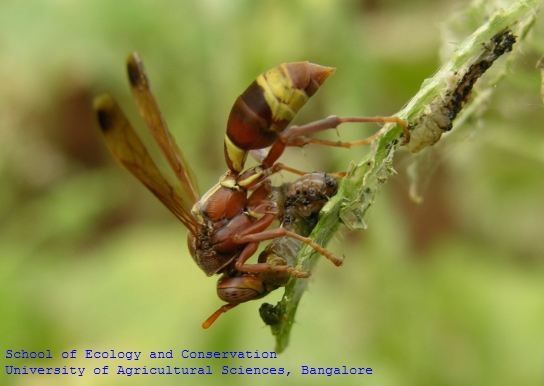- Polistinae
image_caption = "Polistes stigma" from India
regnum =Animal ia
phylum =Arthropod a
classis =Insect a
ordo =Hymenoptera
subordo =Apocrita
superfamilia =Vespoidea
familia =Vespidae
subfamilia = Polistinae
subdivision_ranks = Tribes
subdivision =Polistini Mischocyttarini Ropalidiini Epiponini The Polistinae are
eusocial wasp s closely related to the more familiaryellowjacket s, but placed in their own subfamily, containing four tribes; with some 1100 species total, it is the second most diverse subfamily withinVespidae , and while most species are tropical or subtropical, they include some of the most frequently-encountered large wasps in temperate regions. They are also known aspaper wasp s, which is a misleading term since other wasps (including yellowjackets) also build nests out of paper, and because some Epiponine wasps (e.g., "Polybia emaciata ") build theirs out of mud [http://www.insectscience.org/2.3/O'Donnell_and_Jeanne,_JIS_2.3_2002.pdf] , nonetheless, the name "paper wasp" seems to apply mostly, but not exclusively, to the Polistinae, especially thePolistini . The brood cells are arranged in a hexagonal array, similar to the comb structure in ahoney bee nest. At least one Epiponine species ("Brachygastra mellifica ") storeshoney in the comb, one of the only insects other than bees to store honey.Characteristics of Polistinae are:
* queens (reproductive females) morphologically similar to workers, though sometimes slightly larger or differently colored
* the abdomen is spindle-shaped, often petiolate
* the antennae of males are curled
* the nest is sometimes open (the nests of vespines are typically enclosed in several layers of paper)Colony life cycle
Polistine wasps found colonies in one of two ways. In some species, nests are founded by a small number of reproductive females, possibly a single one. One of the foundresses eventually acquires dominance over the other and is the sole reproducer. The nest is open (not enclosed by an envelope) and contains a single comb.
In the other group, called "swarm-founding", the nest is founded by a large number of workers and a few queens. It is usually protected by an envelope, like a vespine nest.
Selected species of Polistinae
Tribe
Polistini
* Genus "Polistes "
** "P. bellicosus"
** "P. bischoffi"
** "P. carolinus"
** "P. dominula"
** "P. humilis"
** "P. tepidus"Tribe
Mischocyttarini
* Genus "Mischocyttarus "
** "M. collarellus"
** "M. flavitarsis"
** "M. labiatus"Tribe
Epiponini
* Genus "Brachygastra "
**"B. mellifica"* Genus "
Polybia "
** "P. emaciata"
** "P. occidentalis"
** "P. scutellaris"Tribe
Ropalidiini
* Genus "Ropalidia "
**"R. marginata"
** "R. revolutionalis"External links
* [http://es.rice.edu/projects/Bios321/social.wasp.home.html Social Behavior of Polistine Wasps]
* [http://www.qmuseum.qld.gov.au/inquiry/leaflets/leaflet0031.pdf Article on Australian Paper Wasps]
* [http://www.qmuseum.qld.gov.au/inquiry/leaflets/leaflet0031.pdf Nest defence behavior in two species of "Polybia"]
* [http://www.ias.ac.in/currsci/jun102003/1464.pdf Ropalidia marginata a primitive eusocial wasp]
* [http://users.swing.be/entomologie/Vespidae%20of%20the%20World1.htm Iconography of the Vespidae of the World ]
Wikimedia Foundation. 2010.

